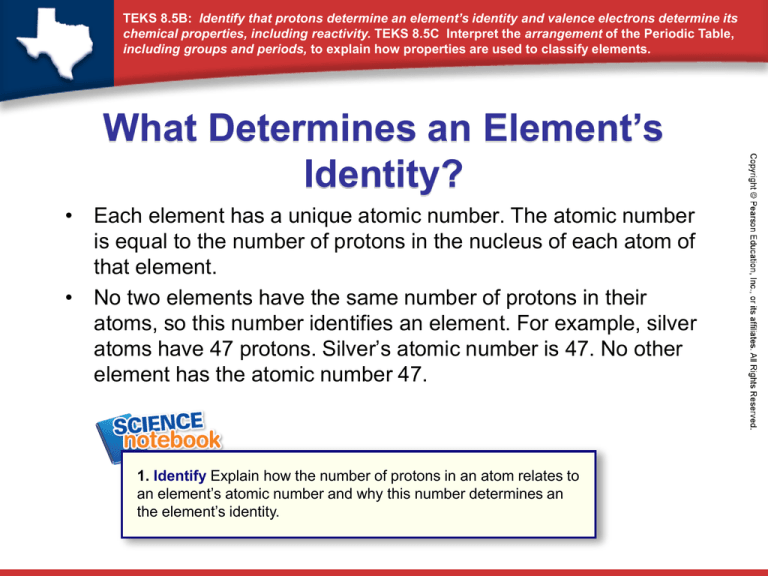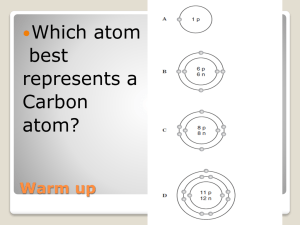(contd.) How do Valence Electrons Determine an Element`s
advertisement

TEKS 8.5B: Identify that protons determine an element’s identity and valence electrons determine its chemical properties, including reactivity. TEKS 8.5C Interpret the arrangement of the Periodic Table, including groups and periods, to explain how properties are used to classify elements. What Determines an Element’s Identity? • Each element has a unique atomic number. The atomic number is equal to the number of protons in the nucleus of each atom of that element. • No two elements have the same number of protons in their atoms, so this number identifies an element. For example, silver atoms have 47 protons. Silver’s atomic number is 47. No other element has the atomic number 47. 1. Identify Explain how the number of protons in an atom relates to an element’s atomic number and why this number determines an the element’s identity. TEKS 8.5B: Identify that protons determine an element’s identity and valence electrons determine its chemical properties, including reactivity. TEKS 8.5C Interpret the arrangement of the Periodic Table, including groups and periods, to explain how properties are used to classify elements. How do Valence Electrons Determine an Element’s Chemical Properties? • Valence electrons of an atom are those electrons that are involved in chemical bonding. When forming chemical bonds, atoms may lose, gain, or share valence electrons. • An element’s chemical properties, including its reactivity, depend on how easily its atoms gain, lose, or share valence electrons. • Look at the periodic table of the elements that follows. The table will help you understand how to identify the number of valence electrons in the atoms of some elements. It will also help you understand the properties of elements. 2. Observe Describe at least three characteristics about the periodic table that you can observe. (contd.) TEKS 8.5B: Identify that protons determine an element’s identity and valence electrons determine its chemical properties, including reactivity. TEKS 8.5C Interpret the arrangement of the Periodic Table, including groups and periods, to explain how properties are used to classify elements. TEKS 8.5B: Identify that protons determine an element’s identity and valence electrons determine its chemical properties, including reactivity. TEKS 8.5C Interpret the arrangement of the Periodic Table, including groups and periods, to explain how properties are used to classify elements. How do Valence Electrons Determine an Element’s Chemical Properties? • The number of valence electrons increases from left to right across a period. Each period begins with an element that has 1 valence electron and ends with an element that has 8 (except for Period 1). • Atoms tend to be unreactive, or stable, when they have 8 valence electrons. The atoms of elements in Group 18 have 8 valence electrons, so these elements usually don’t react with other elements. 3. Identify Use a periodic table to find an example of a reactive element and an unreactive element. Explain the reasoning for your choices. (contd.) TEKS 8.5B: Identify that protons determine an element’s identity and valence electrons determine its chemical properties, including reactivity. TEKS 8.5C Interpret the arrangement of the Periodic Table, including groups and periods, to explain how properties are used to classify elements. How do Valence Electrons Determine an Element’s Chemical Properties? The position of an element in the periodic table tells you about more than just its valence electrons. It also tells you about its properties. • Metals (shown in blue) on the left of the table, are very reactive because their atoms lose valence electrons easily. The reactivity of metals decreases from left to right. • The reactivity of nonmetals (shown in orange) generally increases from left to right, in Groups 14 through 17. Atoms of these elements can gain or share electrons. However, nonmetals are mostly unreactive. 4. Interpret Describe how the arrangement of the periodic table, including groups and periods, helps you to explain how properties are used to classify elements.







![Semiconductor Theory and LEDs []](http://s2.studylib.net/store/data/005344282_1-002e940341a06a118163153cc1e4e06f-300x300.png)



